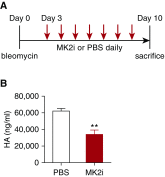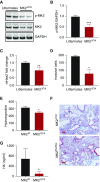Mitogen-activated Protein Kinase-activated Protein Kinase 2 Inhibition Attenuates Fibroblast Invasion and Severe Lung Fibrosis
- PMID: 30130411
- PMCID: PMC6348722
- DOI: 10.1165/rcmb.2018-0033OC
Mitogen-activated Protein Kinase-activated Protein Kinase 2 Inhibition Attenuates Fibroblast Invasion and Severe Lung Fibrosis
Abstract
Severe pulmonary fibrosis such as idiopathic pulmonary fibrosis (IPF) is characterized by the accumulation of extracellular matrix and fibroblast activation. Targeting fibroblast activation has contributed to the development of antifibrotic therapeutics for patients with IPF. Mitogen-activated protein kinase-activated protein kinase 2 (MK2), downstream in the transforming growth factor-β/p38 mitogen-activated protein kinase pathway, has been implicated in inflammatory and fibrosing diseases. Increased concentrations of activated MK2 were expressed in IPF lung and in the mouse bleomycin model of lung fibrosis. The aim of the present study was to determine the role and the mechanisms of MK2 in fibroblast invasion and lung fibrosis. Our results showed that an MK2 inhibitor (MMI-0100) was able to inhibit the invasive capacity of lung fibroblasts isolated from patients with IPF, as well as fibroblasts isolated from both wild-type mice and mice with overexpressing hyaluronan synthase 2 (HAS2) in the myofibroblast compartment. We previously showed that hyaluronan and HAS2 regulate fibroblast invasion and lung fibrosis in vivo. The results of the present study showed that MMI-0100 reduced transforming growth factor-β-induced hyaluronan production in human and mouse fibroblasts in vitro and that HAS2 mediated MK2 activation, suggesting a feed-forward loop in fibroblast activation. More importantly, MK2 inhibition attenuated hyaluronan accumulation and reduced collagen content in bleomycin-injured mouse lungs in vivo. Conditional deletion of MK2 in fibroblasts attenuated bleomycin-induced lung fibrosis. These data provide evidence that MK2 has a role in fibroblast invasion and fibrosis and may be a novel therapeutic target in pulmonary fibrosis.
Keywords: fibroblast invasion; hyaluronan synthase 2; idiopathic pulmonary fibrosis; lung fibrosis; mitogen-activated protein kinase.
Figures







References
-
- American Thoracic Society; European Respiratory Society. Idiopathic pulmonary fibrosis: diagnosis and treatment. International consensus statement. Am J Respir Crit Care Med. 2000;161:646–664. - PubMed
-
- Martinez FJ, Collard HR, Pardo A, Raghu G, Richeldi L, Selman M, et al. Idiopathic pulmonary fibrosis. Nat Rev Dis Primers. 2017;3:17074. - PubMed
-
- Olson AL, Swigris JJ, Lezotte DC, Norris JM, Wilson CG, Brown KK. Mortality from pulmonary fibrosis increased in the United States from 1992 to 2003. Am J Respir Crit Care Med. 2007;176:277–284. - PubMed
-
- Lederer DJ, Martinez FJ. Idiopathic pulmonary fibrosis. N Engl J Med. 2018;378:1811–1823. - PubMed
Publication types
MeSH terms
Substances
Grants and funding
LinkOut - more resources
Full Text Sources
Other Literature Sources
Medical

